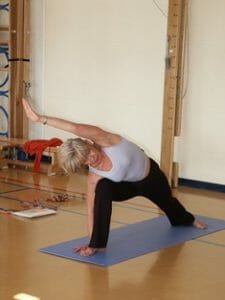Yoga is one of the most popular forms of exercise. It helps to relax your mind and body, while also working various muscle groups.
There are also over 100 types of Yoga making it possible for everyone to find the one that is perfect for them.
However, while Yoga might be considered a “less strenuous form of exercise” it is still possible to incur an injury. This might be surprising to many, but injuries due to Yoga are possible and more common than you might realize.
This doesn’t mean that you have to give up your favorite poses, only be aware of the potential risks for injuries.
Common Yoga Injuries

It is estimated that over 20 million people in the U.S. practice Yoga, at least 3 times a week. For most, it is a part of their everyday routine.
There is no doubt that Yoga can be beneficial. Muscle strength and flexibility can be improved. Stress and anxiety lessened. Some research has even found that the activity can lower blood pressure.
While the benefits are indisputable, not performing a pose in the correct manner can result in painful injuries.
Some of these injuries can occur over time, while others can appear the moment you stretch the wrong way.
According to instructors at Yoga Union, Sol Yoga and Body Space Fitness these are the most common injuries to watch out for.
Wrists: You’ll often find that your wrists are providing support throughout various poses. Dog Down and the Crow pose are only a couple of examples. Over time this can cause joint and muscle injuries.
Elbows: Certain poses such as the chaturanga, if not done properly, can put stress on your elbows.
Shoulders: It’s not uncommon for people to raise their shoulders up during certain poses such as the “up dog”. When this is repeated over time muscles can be injured.
Ribs: Twisting can release tension but the muscles between the ribs can be strained or bruised.
Lower Back: This is one of the most common injury complaints from yoga practitioners. It often occurs when you “round” your spine, instead of keeping it straight. Some poses that can cause stress and strain on your spine if not performed correctly include “down dog” and “forward folds”.
Hamstrings: You can easily pull your hamstrings during yoga, especially during some poses that call for “forward bends”.
Hips: “Warrior”, splits and “wide legged forward” poses can strain your hips if you do not perform these and similar poses properly.
Knees: Just relaxing in the “crossed legged” position can ease tension, but it can also result in knee pain if your holding your hips to tight.
Neck: Shoulder and head stands can put added pressure on the neck resulting in pain, along with possible joint issues.
While, there are some risks associated with Yoga if you perform the poses correctly and do not try any that are above your skill or flexibility level there is no reason why this mind and body activity can’t be a positive addition in your life.
Yoga Poses That Could Cause Injuries

Some forms of Yoga are designed for experienced practitioners, and even then, there is still a risk for injuries. Some of the poses that beginners shouldn’t try until they are ready are,
- Plow Pose or Salamba Sarvangasana (shoulder stand): These poses require you to prop the body on your shoulders, while keeping your legs straight up. Often the body’s weight rests on the cervical vertebrae in the neck, resulting in pressure that could result in an injury.
- Sirasana (head stand): There is always a lot of strain applied, especially to the neck, hands and shoulders, when performing this pose. There is also the chance that you could lose your balance and risk throwing your back out.
- Bridge, Lotus, Cobra, Wheel and Camel (back bends): Since you are “curving” your chest and back, while also pushing your hips forward so your head is extended backwards, injuries can occur if you have any pre-existing conditions or are not flexible enough yet to safely perform these poses.
- Vajrasana (resting on the heels): Injuries from this, and similar poses, are more common in Yoga instructors but can occur in anyone. Spending a lot of time with the majority of your weight resting on your heels can cause sciatic nerve pain. This occurs when the blood supply is cut off from the nerves that are in your heels and feet.
This does not mean that you should not attempt these, and other poses, only make sure you are ready and know how to perform them properly.
How to Avoid Common Yoga Injuries
 There are several methods that will help you avoid many injuries that can cause a yoga related pain. Oftentimes, the injury is a result of putting to much strain and stress on a specific body part or not performing the pose correctly.
There are several methods that will help you avoid many injuries that can cause a yoga related pain. Oftentimes, the injury is a result of putting to much strain and stress on a specific body part or not performing the pose correctly.
Some tips that will help you stay safe and enjoy all the benefits Yoga offers are,
- Stretching: Stretching slowly and carefully before attempting any pose, whether it is geared for beginners or experienced practitioners, is one of the best ways to prevent yoga related injuries. Paying particular attention to your hamstrings, calves and hips will help to loosen tight muscles. One thing you do want to remember is to be careful not to overstretch. This can worsen existing injuries or even cause one. The key is to take your time and be aware of your limits.
- Ease into Yoga: Don’t attempt advanced poses if you are just starting out. While Yoga may be considered an activity that helps to relax the mind and body, some poses and types are definitely not geared for beginners. The first thing you need to do is to build a foundation so your body can support the more advanced poses.
- Don’t “bounce” out of a pose: Yoga often requires you to hold a pose for several minutes at a time. Jumping straight from one pose to another can result in an injury, often to your back, neck or hamstrings. Gently ease from one position to another, and don’t be afraid to stretch again before moving onto to the next pose. This is one of the easiest ways to prevent an injury.
- Communicate: If you are taking a Yoga class, talk to your teacher. Let them know your skill level and if you have any pre-existing conditions that could put you at a greater risk for injuries. For those who prefer to practice at home, first speak with your health care provider to ensure that there won’t be any problems. Also, don’t start a class that is above your skill level. This only increases your chances for problems to occur.
- Do Not lock your joints: One of the main causes of injuries to your wrists, elbows, shoulders and neck is when you “lock” your joints in place. Along with holding the pose correctly, try to use the muscles around the joints. This will help prevent joint injuries due to hyper-extension.
- Use Props: If you can’t hold a pose without a prop or by modifying it, do not be ashamed. It doesn’t mean that you’ve failed, only that your body isn’t ready yet. Letting your body get used to a pose before trying it on your own will prevent muscle tears, strains and other common injuries.
- Don’t skip savasana: It’s often tempting to skip this last part, after all it’s only a “resting pose”. However, performing this pose after a session gives your body a chance to slow down. Not only will it help you to relax, it can also be beneficial to your physical and mental health.
- Listen to your body: If you “feel” like something isn’t right with your body, stop the session immediately. Often your body will give warning signals before an injury occurs. Sometimes it could be a pose that you’ve never had a problem with or it could be one you’re trying for the first time. It is always better to “be safe than sorry”.
- Don’t have an ego: It doesn’t matter how good of an athlete you are, if you rush into a type of Yoga or pose before you are ready your risk for an injury will increase. The practice of Yoga is based on finding out where you are, not where you think you should be. Take your time and go slowly, you’ll be glad you did when you are injury free.
If an injury does occur don’t ignore it or try to treat it on your own. Speak to your primary health care provider, and don’t attempt any poses until you are fully healed.
Gentle Yoga Poses
 If you are worried about injuring yourself or are just starting out, there are some poses that seem to present less of a risk for injury.
If you are worried about injuring yourself or are just starting out, there are some poses that seem to present less of a risk for injury.
- Lunges: Gently stretch the hamstrings, while also building leg strength.
- Chair Pose (squats): Work the muscles in the core, back, legs and thighs. Tip: Keep your back straight and tailbone tucked in. This way you’ll get the full benefit, while minimizing your risk for injury.
- Forward Bends: Stretch the back and hamstrings. Remember to straighten your legs slowly to avoid tears or strain.
- Side Bends: Stretch the side muscles, just don’t twist to fast. Take your time and also, do not yank or jolt your neck.
- Pranayama (breathing exercises): Help the body warm-up and reduce stress, along with anxiety. Some Yoga practitioners even use these exercises to help them sleep or even handle stressful situations throughout the day.
- Seated positions: Can often be done if you have an injury, though first talk to your physician. One pose is the “happy baby”, which still allows you to stretch your quadriceps without putting strain on the rest of your body.
These are only a few examples of “gentle” yoga poses that have a low risk for injury, while still providing you with the benefits you are looking for.
Practice Yoga Safely
 Like any physical activity there is a risk for injury when you are practicing Yoga. While some aches and pains can be unavoidable due to pre-existing conditions, you can lessen your chances.
Like any physical activity there is a risk for injury when you are practicing Yoga. While some aches and pains can be unavoidable due to pre-existing conditions, you can lessen your chances.
Just remember to not push yourself too hard, and always “listen” to your body. If you do feel like something could be wrong, don’t wait until you are in pain. Talk to your instructor and physician, and do not push yourself past your limits.
Yoga is designed to help you “discover yourself”, not to try and be better than everyone else. It’s your journey, so take your time and enjoy all of the mental and physical benefits that can come with Yoga.

Leave A Comment